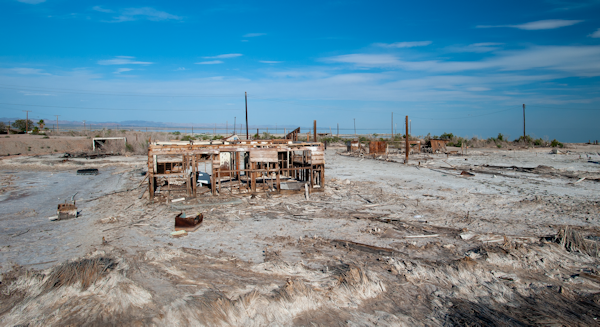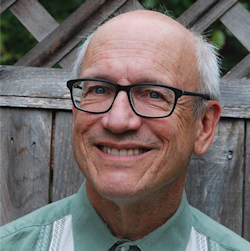SEJournal Online is the digital news magazine of the Society of Environmental Journalists. Learn more about SEJournal Online, including submission, subscription and advertising information.
 |
 |
| Remains of decaying buildings along the shore of the Salton Sea, which has been shrinking for years, leaving increasingly vulnerable nearby immigrant communities. Photo: Steve Payer/California Department of Water Resources. |
Inside Story: Unique Podcast Team Gives Voice to Troubled Communities Near Declining Salton Sea
When reporters for the Living Downstream podcast sought to tell the story of the decline of California’s largest lake for Northern California Public Media’s KRCB-FM, they chose to focus on the experience of nearby Spanish-speaking populations. That community, said judges for the Society of Environmental Journalists’ 2022 Awards for Reporting on the Environment, “often feels it is being erased in the telling of the complex narratives that shape the reality of the Salton Sea.”
The judges added that “The Sea Next Door” project “used the power of first-person storytelling and all the tools of the podcast medium to unravel the complex elements that in turn weave together the troubled ecology of a desert lake in a near constant state of flux. … It is a Herculean effort that wrestles with a subject as large as the lake itself. Bravo.”
The effort ultimately took the third-place prize in the explanatory reporting, small, category, with extra praise for student field reporters Adriana Torres and Rosa Gonzalez-Andrade for their close work with experienced storytellers Olivia Rodriguez Mendez, Molly Peterson and Story Editor Steve Mencher.
SEJournal recently caught up with Mencher by email to talk about the project. Here is the conversation.
SEJournal: How did you get your winning story idea?
 |
Steve Mencher: Our Living Downstream podcast has now completed two full seasons. As we've discovered stories from around the country and the world, it became clear to us that working with communities to tell their own stories would be the most valuable thing we could do. Producer and science reporter Molly Peterson knew that there would be stories in the Eastern Coachella Valley revolving around California's biggest lake, the Salton Sea. She assembled a team including documentarian Olivia Rodriguez Mendez and high school seniors Rosa Gonzalez and Adriana Torres. It soon became clear that the problems and possibilities of this troubled lake would make a great story.
SEJournal: What was the biggest challenge in reporting the piece and how did you solve that challenge?
Mencher: Centering the two high school students in the story meant that Molly and Olivia needed to train them how to tell stories with audio while they were assembling the episode. And the story needed to unfold at its own pace, as we presented the work of scientists at the lake and other events over several months. Also, our young reporters were finishing up their high school days and getting ready to go on to college. Molly and Olivia found time with them when they were available, but the commitment of all to tell this story never wavered. Add to this the maddening fact that nobody at any level of government was taking responsibility for the growing ecological disaster at the lake. In every case, the solution to most challenges was patience, kindness, humility and respect.
SEJournal: What most surprised you about your reporting?
‘It was surprising, though perhaps it shouldn't be,
that local, state and federal authorities cared so little
about the lives of people in these communities.’
Mencher: We were surprised by the knowledge embedded in communities, where residents of so-called sacrifice zones and victims of environmental injustice were organizing with increasing effectiveness to make their voices heard. This was particularly true as we dug into stories near the Salton Sea. It was surprising, though perhaps it shouldn't be, that local, state and federal authorities cared so little about the lives of people in these communities. And it was heartening and surprising that so many scientists were devoting themselves to showing up for communities, and teaching them how to measure and monitor their air, water and land for poisons being dumped in communities of color and those where economic hardship is the norm.
SEJournal: How did you decide to tell the story and why?
Mencher: When we started our series in 2017, environmental justice was a well-known phrase, but it wasn't being singled out as a set of stories that could be told and connected. Going forward during our second season, we tried to connect the dots between environmental injustice, climate change, COVID-19 and community action, and we sought out stories that were in overlapping spaces. When we considered telling the story of the Eastern Coachella Valley, it was important that we could connect authentically with people who lived there, and that we could amplify their voices.
SEJournal: Does the issue covered in your story have a disproportionate impact on people of low income, or people with a particular ethnic or racial background? What efforts, if any, did you make to include perspectives of people who may feel that journalists have left them out of public conversation over the years?
‘We had to flip our usual process 180 degrees
in order to center the two high school seniors
who would host this episode of our podcast.’
Mencher: The story recognized by SEJ highlighted issues that largely impact the farmworker, Mexican immigrant and Mexican-American community in the Eastern Coachella Valley near the Salton Sea. We had to flip our usual process 180 degrees in order to center the two high school seniors who would host this episode of our podcast. We took our cues from them in terms of how we spoke about their families and community, versus what an outsider might say.
SEJournal: What would you do differently now, if anything, in reporting or telling the story and why?
Mencher: Perhaps there would have been a way to bring the story together faster. It also would have been useful to plan from the start a helpful feedback loop, where we brought our work back to the community, solicited feedback and then incorporated that feedback into the work. It also might have helped if our metrics were specifically based on impact. That is, what changes did we want our reporting to instigate and how did we plan to measure that impact. If we had the resources, we would have continued our contact with the community beyond the publishing of our podcast episode, to see what changes were happening and how we could continue to support them. Along that line, what if we had been able to support a community storytelling initiative, training more people to tell their own stories and find outlets for them?
SEJournal: What lessons have you learned from your story?
Mencher: We could always get better at listening and it's important to listen with nuance. We were told early on by our young narrators that people hated when reporters and others from outside the community came and told them that the centerpiece of their world, the Salton Sea, was "dying." We were then a bit surprised when those in the community, in their own words, used this description. But it's not hard to see the difference — it's OK if we say this about ourselves, but don't come into our community and tell us things we already know and which may make you feel superior to us.
SEJournal: What practical advice would you give to other reporters pursuing similar projects, including any specific techniques or tools you used and could tell us more about?
‘When you show up in a community, don't start by
shoving a camera or microphone in someone's face.
Rather, come humbly and start by listening.’
Mencher: This is something I learned from Sue Schardt, who was former CEO of the Association of Independents in Radio, now AIR. When you show up in a community, don't start by shoving a camera or microphone in someone's face. Rather, come humbly and start by listening. Once you've established relationships and trust, then it's fine to bring the recording devices, but not until then.
SEJournal: Could you characterize the resources that went into producing your prizewinning reporting (estimated costs, i.e., legal, travel or other; or estimated hours spent by the team to produce)? Did you receive any grants or fellowships to support it?
Mencher: Our project was supported by a generous grant from one local funder in Northern California. The total cost of producing an episode of our podcast in season two varied between $5,000 and $10,000. Producer Molly Peterson traveled back and forth from Los Angeles to the Eastern Coachella Valley countless times and her hard work inspired the local team of producers, all of whom were compensated, to do their best. That kind of work can't really be duplicated on a shoestring budget a second time, so we are trying to raise funds for our third season to pay everyone appropriately for their work.
SEJournal: Is there anything else you would like to share about this story or environmental journalism that wasn’t captured above?
Mencher: I think I may have covered it. But I'll stick with the mantra of communities being covered by journalists who may not be members of those communities — "nothing about us without us."
Originally from New York City, Steve Mencher has been producing audio and video stories since he worked at Carnegie Hall and NPR in the 1980s. He was an internet pioneer, creating the Smithsonian’s third website, about the White House Collection of American Crafts. He worked for Ovation the Arts Network, the Library of Congress and the Defense Department, doing web work and making radio and television programs. For the Getty Museum, he created audio tours of both its Los Angeles campuses. He was lead producer in 2015-2016 for Beyond Belief, a CPB-funded project from the Association of Independents in Radio, where he reported on how progressive religious leaders were changing Kansas City for the better. In 2017, while news director at Northern California Public Media in Sonoma County, Calif., he launched the award-winning podcast Living Downstream, about environmental justice and climate change. He lives in Baltimore, Maryland.
* From the weekly news magazine SEJournal Online, Vol. 8, No. 35. Content from each new issue of SEJournal Online is available to the public via the SEJournal Online main page. Subscribe to the e-newsletter here. And see past issues of the SEJournal archived here.












 Advertisement
Advertisement 



